
The Cathedral of the Holy Cross and Saint Eulalia, also known as Barcelona Cathedral, is the seat of the Archbishop of Barcelona in Catalonia, Spain. The cathedral was constructed from the thirteenth to fifteenth centuries, with the principal work done in the fourteenth century. The cloister, which encloses the Well of the Geese (Font de les Oques), was completed in 1448. In the late nineteenth century, the neo-Gothic façade was constructed over the nondescript exterior that was common to Catalan churches.

Cuenca is a city and municipality of Spain located in the autonomous community of Castilla–La Mancha. It is the capital of the province of Cuenca.

The Cathedral of Saint Mary of Burgos is a Catholic church dedicated to the Virgin Mary located in the historical center of the Spanish city of Burgos. Its official name is the Holy Metropolitan Cathedral Basilica Church of St Mary of Burgos.

Santa María de Regla de León Cathedral is a Catholic church, the episcopal see of the diocese of León in the city of León, Castile and León, north-western Spain, consecrated under the name of the Virgin Mary. It was the first monument declared by the Royal Order of Spain on August 28, 1844.
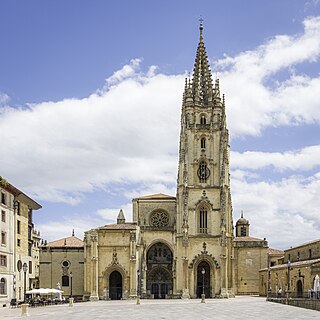
The Metropolitan Cathedral Basilica of the Holy Saviour or Cathedral of San Salvador is a Roman Catholic church and minor basilica in the centre of Oviedo, in the Asturias region of northern Spain.

The Santiago de Compostela Arch cathedral Basilica is part of the Metropolitan Archdiocese of Santiago de Compostela and is an integral component of the Santiago de Compostela World Heritage Site in Galicia, Spain. The cathedral is the reputed burial place of Saint James the Great, one of the apostles of Jesus Christ. It is also among the remaining churches in the world built over the tomb of an apostle, the other ones being St Peter's Basilica in Vatican City, St Thomas Cathedral Basilica in Chennai, India and Basilica of St. John in Izmir, Turkey.

The Catedral de la Asunción de la Virgen, popularly known as New Cathedral is, together with the Old Cathedral, one of the two cathedrals of Salamanca, Castile and León, Spain. It is the seat of the diocese of Salamanca. It was constructed between 1533 and 1733 mixing late Gothic, Plateresque and Baroque styles. It was commissioned by Ferdinand V of Castile. It is one of the largest cathedrals in Spain in size and its bell tower, at 92 meters high, is also one of the tallest.
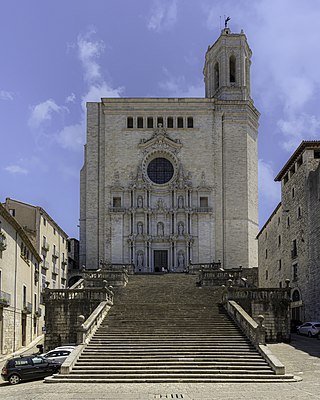
Girona Cathedral, also known as the Cathedral of Saint Mary of Girona, is a Roman Catholic church located in Girona, Catalonia, Spain. It is the seat of the Roman Catholic Diocese of Girona. The cathedral's interior includes the widest Gothic nave in the world, with a width of 23 metres (75 ft), and the second-widest of any church after that of St. Peter's Basilica. Its construction was begun in the 11th century in the Romanesque architectural style, and continued in the 13th century in the Gothic style. Of the original Romanesque edifice only the 12th-century cloister and a bell tower remain. The second bell tower was completed in the 18th century.

The Cathedral of Zamora is a Catholic cathedral in Zamora, in Castile and León, Spain, located above the right bank of the Duero It remains surrounded by its old walls and gates.
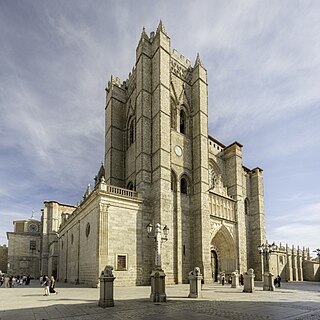
The Cathedral of the Saviour is a Catholic church in Ávila in the south of Old Castile, Spain. It was built in the late Romanesque and Gothic architectural traditions.

Pamplona Cathedral(Santa María de la Asunción) is a Roman Catholic church in the archdiocese of Pamplona, Spain. The current 15th century Gothic church replaced an older Romanesque one. Archaeological excavations have revealed the existence of another two earlier churches. The Neoclassical façade was designed by Ventura Rodríguez in 1783. It has a 13th-14th-century Gothic cloister that provides access to two other Gothic rooms: the Barbazan chapel and the refectory. The Mediaeval kings of Navarre were crowned and some also buried there. The Navarrese Cortes (Parliament) was held there during the early modern ages.

The Cathedral of San Cristóbal de La Laguna or Catedral de Nuestra Señora de los Remedios is a Roman Catholic church in Tenerife, Spain. Begun in 1904 and completed in 1915, it is dedicated to the Virgin of Los Remedios. The cathedral is the mother church of the diocese, which includes the islands of Tenerife, La Palma, La Gomera and El Hierro in the province of Santa Cruz de Tenerife. It is therefore where the episcopal seat of the bishop of this diocese, currently occupied by Bishop Bernardo Álvarez Afonso. This is one of the most important churches of the Canary Islands.

The Cathedral of Santa María, known as the Old Cathedral, is one of the two cathedrals in Salamanca, Castile and León, Spain. Founded by Bishop Jerome of Périgord, its construction began in the first third of the 12th century and was finished at the end of the 14th century, in Romanesque and Gothic style. It was finished thanks to the impulse given to the works by Bishop Alfonso Barasaque. It is dedicated to Saint Mary of the See.

Saint Mary's Cathedral, better known as Lugo Cathedral, is a Roman Catholic church and basilica in Lugo, Galicia, north-western Spain. The cathedral was erected in the early 12th century in a Romanesque style, with Gothic, Baroque and Neoclassical elements.

The Cathedral of Sigüenza, officially Catedral de Santa María de Sigüenza, is the seat of the bishop of Sigüenza, in the town of Sigüenza, in Castile-La Mancha, Spain. It was declared Bien de Interés Cultural in 1931.
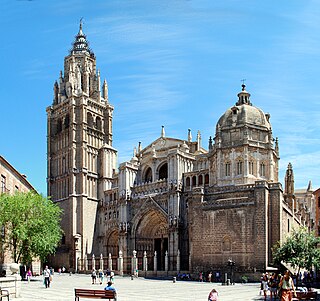
The Primatial Cathedral of Saint Mary of Toledo, otherwise known as Toledo Cathedral, is a Roman Catholic church in Toledo, Spain. It is the seat of the Metropolitan Archdiocese of Toledo.

The Cathedral of the Assumption of Our Lady of Segorbe is a Roman Catholic church in Segorbe, province of Castellón, Spain. It is the see of the Diocese of Segorbe-Castellon. It was elevated to the rank of minor basilica in 1985.

The Catedral of Saint Mary of Tortosa is a cathedral located in Tortosa, Catalonia, Spain and seat of the Diocese of Tortosa. The present structure is located in the center of the city's old town.

The Ourense Cathedral is a Roman Catholic church located in Ourense in Galicia. Dedicated to St Martin, it was founded in 550. The first structure was restored by Alonso el Casto. The present mainly Gothic building was raised with the support of Bishop Lorenzo in 1220. Its local patroness is Saint Euphemia. There is a silver-plated shrine, and others of St Facundus and St Primitivus. The Christ's Chapel was added in 1567 by Bishop San Francisco Triccio. It contains an image of Christ, which was brought in 1330 from a small church on Cape Finisterre. John the Baptist's Chapel was created in 1468 by the Conde de Benavente. The Portal of Paradise is sculptured and enriched with figures of angels and saints, while the antique cloisters were erected in 1204 by Bishop Ederonio. The Capilla de la Maria Madre was restored in 1722, and connected by the cloisters with the cathedral. The eight canons were called Cardenales, as at the Cathedral of Santiago de Compostela, and they alone did services before the altar; this custom was recognised as "immemorial" by Pope Innocent III, in 1209. The cathedral, which has undergone an impressive transition of architectural styles of Romanesque, Gothic, Renaissance, Baroque and Neoclassical, was built to a Latin Cross plan. It has been a functional basilica since 1887. The cathedral has a crucifix that is held in great reverence all over Galicia.
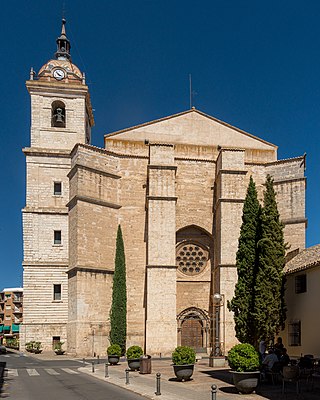
The Holy Priory Church Cathedral Basilica of the Military Orders of Our Lady Saint Mary of the Prado, also known as the Cathedral of Saint Mary of the Prado for short, is located in Ciudad Real, autonomous region of Castile-La Mancha, Spain.






























